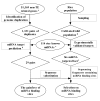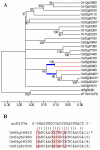Selection and mutation on microRNA target sequences during rice evolution
- PMID: 18831738
- PMCID: PMC2567346
- DOI: 10.1186/1471-2164-9-454
Selection and mutation on microRNA target sequences during rice evolution
Abstract
Background: MicroRNAs (miRNAs) posttranscriptionally down-regulate gene expression by binding target mRNAs. Analysis of the evolution of miRNA binding sites is helpful in understanding the co-evolution between miRNAs and their targets. To understand this process in plants a comparative analysis of miRNA-targeted duplicated gene pairs derived from a well-documented whole genome duplication (WGD) event in combination with a population genetics study of six experimentally validated miRNA binding sites in rice (O. sativa) was carried out.
Results: Of the 1,331 pairs of duplicate genes from the WGD, 41 genes (29 pairs) were computationally predicted to be miRNA targets. Sequence substitution analysis indicated that the synonymous substitution rate was significantly lower in the miRNA binding sites than their 5' and 3' flanking regions. Of the 29 duplicated gene pairs, 17 have only one paralog been targeted by a miRNA. This could be due to either gain of a miRNA binding site after the WGD or because one of the duplicated genes has escaped from being a miRNA target after the WGD (loss of miRNA binding site). These possibilities were distinguished by separating miRNAs conserved in both dicots and monocot plants from rice-specific miRNAs and by phylogenetic analysis of miRNA target gene families. The gain/loss rate of miRNA binding sites was estimated to be 3.0 x 10(-9) gain/loss per year. Most (70.6%) of the gains/losses were due to nucleotide mutation. By analysis of cultivated (O. sativa; n = 30) and wild (O. rufipogon; n = 15) rice populations, no segregating site was observed in six miRNA binding sites whereas 0.12-0.20 SNPs per 21-nt or 1.53-1.80 x 10(-3) of the average pairwise nucleotide diversity (pi) were found in their flanking regions.
Conclusion: Both molecular evolution and population genetics support the hypothesis that conservation of miRNA binding sites is maintained by purifying selection through elimination of deleterious alleles. Nucleotide mutations play a major role in the gain/loss of miRNA binding sites during evolution.
Figures


Similar articles
-
Genomic analysis of rice microRNA promoters and clusters.Gene. 2009 Feb 15;431(1-2):61-6. doi: 10.1016/j.gene.2008.11.016. Epub 2008 Nov 24. Gene. 2009. PMID: 19073239
-
Molecular evolution and selection of a gene encoding two tandem microRNAs in rice.FEBS Lett. 2007 Oct 2;581(24):4789-93. doi: 10.1016/j.febslet.2007.09.002. Epub 2007 Sep 12. FEBS Lett. 2007. PMID: 17884044
-
Transcriptome-wide identification of microRNA targets in rice.Plant J. 2010 Jun 1;62(5):742-59. doi: 10.1111/j.1365-313X.2010.04187.x. Epub 2010 Feb 26. Plant J. 2010. PMID: 20202174
-
Evolution of plant microRNA gene families.Cell Res. 2007 Mar;17(3):212-8. doi: 10.1038/sj.cr.7310113. Cell Res. 2007. PMID: 17130846 Review.
-
MicroRNA-directed regulation: to cleave or not to cleave.Trends Plant Sci. 2008 Jul;13(7):359-67. doi: 10.1016/j.tplants.2008.03.007. Epub 2008 May 22. Trends Plant Sci. 2008. PMID: 18501664 Review.
Cited by
-
Small RNAs originated from pseudogenes: cis- or trans-acting?PLoS Comput Biol. 2009 Jul;5(7):e1000449. doi: 10.1371/journal.pcbi.1000449. Epub 2009 Jul 31. PLoS Comput Biol. 2009. PMID: 19649160 Free PMC article.
-
The miR9863 family regulates distinct Mla alleles in barley to attenuate NLR receptor-triggered disease resistance and cell-death signaling.PLoS Genet. 2014 Dec 11;10(12):e1004755. doi: 10.1371/journal.pgen.1004755. eCollection 2014 Dec. PLoS Genet. 2014. PMID: 25502438 Free PMC article.
-
Systematic analysis reveals cis and trans determinants affecting C-to-U RNA editing in Arabidopsis thaliana.BMC Genet. 2020 Sep 3;21(1):98. doi: 10.1186/s12863-020-00907-6. BMC Genet. 2020. PMID: 32883207 Free PMC article.
-
miR398 targets a Cu2+-containing Selenium Binding Protein (SBP) in rice and the phylogenetic analysis of the miR398-SBP module in plants.BMC Plant Biol. 2025 Feb 10;25(1):167. doi: 10.1186/s12870-025-06202-9. BMC Plant Biol. 2025. PMID: 39924490 Free PMC article.
-
Probing Evolutionary Biography of MicroRNAs and Associated Factors.Curr Genomics. 2012 Apr;13(2):144-52. doi: 10.2174/138920212799860634. Curr Genomics. 2012. PMID: 23024606 Free PMC article.
References
Publication types
MeSH terms
Substances
LinkOut - more resources
Full Text Sources
Research Materials
Miscellaneous

